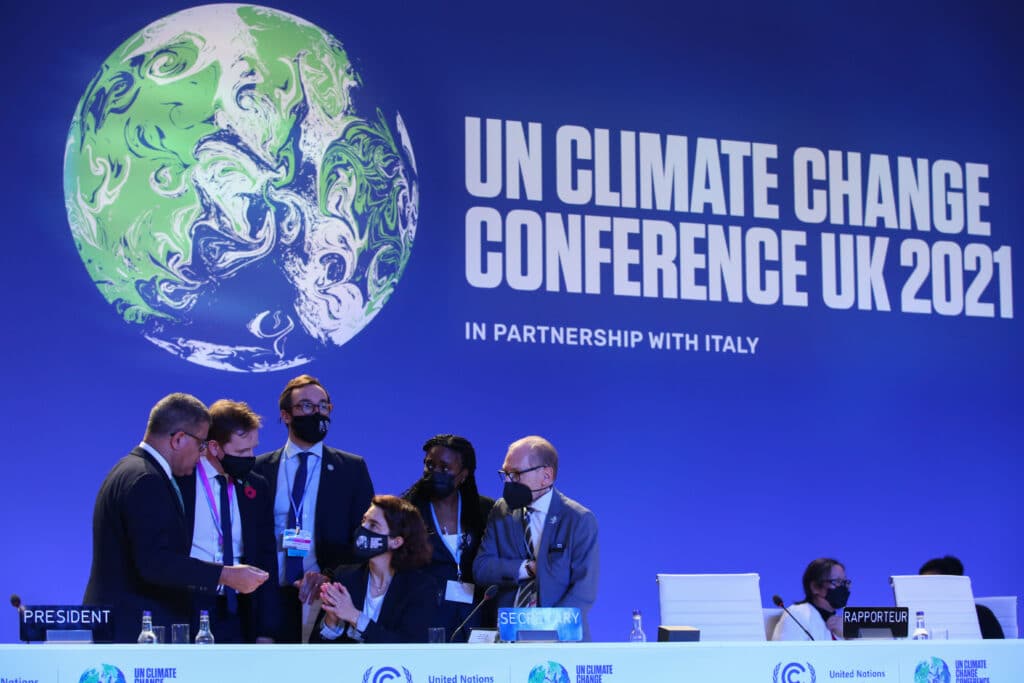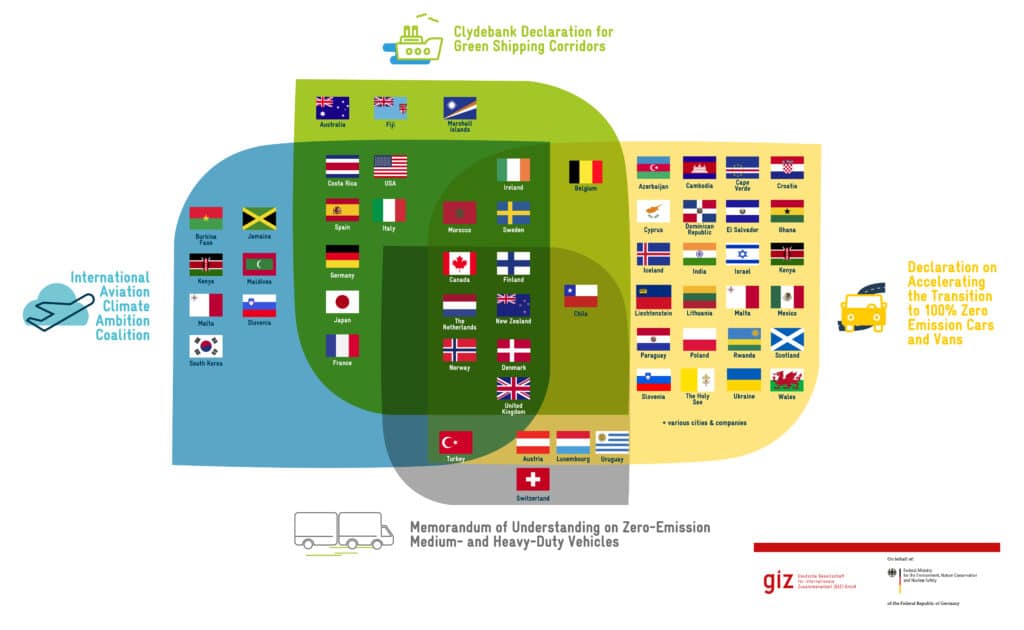
On Saturday night, the British presidency concluded the 26th Conference of the Parties to the United Nations Framework Convention on Climate Change (COP26). The so-called Glasgow Climate Pact was adopted by 197 countries. The document reaffirmed that limiting global warming to 1.5 °C requires rapid, deep and sustained reductions in global greenhouse gas emissions, including reducing global carbon dioxide emissions by 45 per cent by 2030 relative to 2010 levels and to net-zero around mid-century.
UN Secretary General António Guterres clearly communicated that many goals of the conference were not met: “we [i.e. the negotiators] failed at this conference to end fossil fuels subsidies, to phase out coal, to put a price on carbon, to build resilience of vulnerable communities (…), and make good on the $100 billion climate finance commitment (…)”. Nevertheless, he saw some “building blocks for progress”. In this short piece, I will look at these ‘building blocks’ from a transport sector perspective.
When delegates arrived in Scotland two weeks ago, the state of affairs was not very encouraging. The national climate pledges (so called Nationally Determined Contributions, NDCs) that had been submitted throughout the past months only showed limited progress, far from getting the emissions down to 1.5°C or even 2°C.
This also applies to the transport sector. Only 11 countries out of the 30 countries with net-zero targets have medium-term (until 2030) transport sector GHG emission targets in their new or updated NDCs, many of which are small countries. Only 7 additional parties include transport targets in their long-term strategies (LTS).
An new analysis of GIZ and SLOCAT on behalf of the German Federal Ministry for Environment (BMU) concluded – among several other insights – that emissions covered by transport targets only account for 8% of global transport CO2 emissions. Most of the big emitters still lack ambition in transport.
The world is far away from an urgently needed turning point towards sustainable transport. The needs for an immediate and fundamental reduction of transport demand and a shift to renewable electricity as main fuel has been highlighted through a new study of the University of Technology in Sydney, funded through the German Federal Ministry for Economic Cooperation and Development (BMZ).
It describes a 1.5°C pathway for transport assuming a carbon budget of 110 Gt CO2eq for the sector within the next 30 years (based on an overall remaining carbon budget of 400 Gt CO2eq as per the 6th IPCC Assessment Report assuming a 67 % likelihood of limiting global warming). Currently the transport sector is responsible for about 8.5 Gt CO2eq annually. With current growth rates, the carbon budget of the transport sector would be exausted by the early 2030s. The urgency to act is obvious.
While parties failed to agree on more climate finance, and only defined a process for a new financing goal until 2024, there was an upside. More and more countries came up with net-zero emission targets. Even just before and during the COP more countries (e.g. Saudia Arabia and India) came up with long-term pledges. While these are essential for transport in the mid-term, the world saw three important developments that are relevant for transport immediately:
Firstly, the UK presidency has urged countries to enact voluntary commitments and coalitions of the willing as an alternative to contenting themselves with watered-down compromises of the total 197 Parties to the Convention. It is a considerable success that some countries take the lead and move faster to initiate change in the sector.
After initiatives on deforestation and phase-out of coal had been launched in the first week, on Transport Day on November 10th four ambitious transport coalitions were announced. These are:
Figure 1: COP26 statements and declarations on climate action in transport

Nevertheless, it is a pity that reporting on these COP26 initiatives is not covered by the new enhanced transparency framework (see below section on Paris Rulebook). The transport community will need to track the progress of these coalitions with its own resources. Ideally, this includes many other existing initiatives like the MobiliseYourCity Partnership co-funded since 2015 by France, Germany and the European Union.
Secondly, the Glasgow Climate Pact considered the urgency, we are in and requests Parties to revisit and strengthen the 2030 targets in their NDCs by the end of 2022. Ramping up ambition of national climate pledges before the next “official” cycle in 2025 is necessary to not loose time.
Furthermore, updating NDCs next year would increase consistency with new climate pledges and net-zero targets that were announced by several prime ministers in the first week of COP26, which are not yet reflected in their countries NDCs, e.g. Vietnam or India. In case countries committed to voluntary initiative, these could be added as well.
Updating the NDCs is a great chance to strengthen the ambition in transport by developing more and more ambitious sectoral targets. Ideally those would be listed in NDCs and LTS. China, for example, could outline transport emission peaking and reductions in its upcoming sectoral climate plans.
At GIZ we will track these pledges and continue to update our NDC and LTS database, the Tracker of Climate Strategies for Transport.
Thirdly, discussions around more funding for creating more resilient infrastructure and services as well as dealing with damages of climate impacts was hotly debated. Parties finally agreed to double the funding for adaptation and start to work with technical assistance on activities to avert, minimize and address loss and damage. Axel Michaelowa, a long-time observer of COPs, is assuming that the next COP in November 2022 in Sharm-el-Sheik (Egypt) will have a focus on adaptation and loss-and-damage.
This topic is essential for transport infrastructure that already today is severely affected by more and more extreme weather events such as flooding or storms, causing millions of losses in single events. Our analysis showed that especially least developed countries put more emphasis on adaptation in their NDCs. 60% of low-income countries have included adaptation measures in the transport sector.
In addition to these specific opportunities, COP26 is a milestone in international negotiations, because the so-called ‘Paris Rulebook’ has been completed. This framework is needed to ensure joint approaches to the bottom-up ambition process, e.g. through reporting standards and templates, a common timeframe for NDCs or the trading of emission reductions between countries. The transport community must understand these rules and start developing capacities of sectoral stakeholders in order to help them benefit from and contribute to international climate policy.
Part of the Rulebook is the potential generation of “International Transferable Mitigation Outcomes” (ITMOs) from transport mitigation actions. Those ITMOs are certified GHG emission reductions that could be purchased by countries that do not achieve their targest domestically. However, it is questionable, if this is trading of emissions reductions actually leads to real overall emission cuts for transport.
Lambert Schneider of Oeko-Institute fears that carbon credits are ‘double counted’ especially by airlines that offset their emissions under the Carbon Offsetting and Reduction Scheme for International Aviation (CORSIA) adopted by the International Civil Aviation Organization (ICAO). The sector already struggled to verify robust emission reductions under the ‘Clean Development Mechanism’ developed as part of the Kyoto Protocol in 1997. The same barriers may occur again under the new regime. Furthermore, striving for net-zero emissions in the sector would hardly leave any room for such compensations in the mid-term and maybe neither realistic nor desirable at all.
Non-state actors that want to contribute to raise ambition such as regions, cities, NGOs and business will continue to be involved through the Marrakech Partnership on Global Climate Action. The duo of High-Level Climate Champions nominated by the incoming and outgoing COP presidency have been instrumental in developing the initiatives and voluntary agreements that gave hope to participants of COP26.
Gonzalo Muñoz of Chile and Nigel Topping of the United Kingdom have presented a plan on how to continue the partnership until 2025. The most important feature of that plan might be the close link to the global stocktake (aiming to be done before COP28 in Dubai) enabling sustainable transport initiatives to demonstrate to national governments what is feasible in this sector.
Against this background, UN Secretary-General António Guterres announced in his closing speech the intention to create a High-Level Expert Group on establishing clear standards to measure and analyze net-zero commitments from non-state actors.
In a nutshell, Glasgow was not the big success that some had hoped for, but it’s a starting point for shifting up gears for more ambitious and accelerated climate action in transport. Guterres concluded his speech with a famous saying by the Scottish writer Robert Louis Stevenson: “Don’t judge each day by the harvest you reap, but by the seeds that you plant.”
This reminds us, that we all can start today on implementing more ambitious climate action. We need a paradigm shift in how we move, we need to stop high-carbon transport financing and we need to shift investments to sustainable transport modes.
We require both: On the one hand to keep travel distances of people and goods low or to even reduce them and on the other hand to shift all modes to 100% of renewable electricity. This means not only phasing-out coal but oil and the internal combustion engines, too. We need to and can start changing transport today.
Published 16.11.2021
 ©UNFCCC Kiara Worth
©UNFCCC Kiara Worth